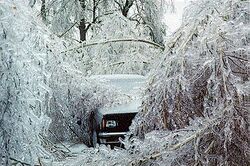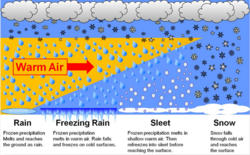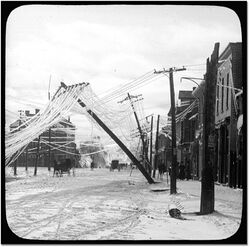Earth:Ice storm
| Part of the nature series |
| Weather |
|---|
An ice storm is a type of winter storm characterized by freezing rain, also known as a glaze event or, in some parts of the United States, as a silver thaw.[1] The U.S. National Weather Service defines an ice storm as a storm which results in the accumulation of at least 0.25-inch (6.4 mm) of ice on exposed surfaces.[2] They are generally not violent storms but instead are commonly perceived as gentle rains occurring at temperatures just below freezing.
Formation
The formation of ice begins with a layer of above-freezing air above a layer of sub-freezing temperatures closer to the surface. Frozen precipitation melts to rain while falling into the warm air layer, and then begins to refreeze in the cold layer below. If the precipitate refreezes while still in the air, it will land on the ground as sleet. Alternatively, the liquid droplets can continue to fall without freezing, passing through the cold air just above the surface. This thin layer of air then cools the rain to a temperature below freezing (0 °C or 32 °F). However, the drops themselves do not freeze, a phenomenon called supercooling (or forming "supercooled drops"). When the supercooled drops strike ground or anything else below 0 °C (32 °F) (e.g. power lines, tree branches, aircraft), a layer of ice accumulates as the cold water drips off, forming a slowly thickening film of ice, hence freezing rain.[3][4][5]
While meteorologists can predict when and where an ice storm will occur, some storms still occur with little or no warning.[4] In the United States, most ice storms are in the northeastern part of the country, but damaging storms have occurred farther south; an ice storm in February 1994 resulted in tremendous ice accumulation as far south as Mississippi, and caused reported damage in nine states.[6]
Effect
The freezing rain from an ice storm covers everything with heavy, smooth glaze ice. In addition to hazardous driving or walking conditions, branches or even whole trees may break from the weight of ice. Falling branches can block roads, tear down power and telephone lines, and cause other damage. Even without falling trees and tree branches, the weight of the ice itself can easily snap power lines and also break and bring down power/utility poles; even electricity pylons with steel frames. This can leave people without power for anywhere from several days to a month. According to most meteorologists, just one quarter of an inch of ice accumulation can add about 500 pounds (230 kg) of weight per line span. Damage from ice storms is easily capable of shutting down entire metropolitan areas.
Additionally, the loss of power during ice storms has indirectly caused numerous illnesses and deaths due to unintentional carbon monoxide (CO) poisoning. At lower levels, CO poisoning causes symptoms such as nausea, dizziness, fatigue, and headache, but high levels can cause unconsciousness, heart failure, and death.[7] The relatively high incidence of CO poisoning during ice storms occurs due to the use of alternative methods of heating and cooking during prolonged power outages, common after severe ice storms.[8] Gas generators, charcoal and propane barbecues, and kerosene heaters contribute to CO poisoning when they operate in confined locations.[7] CO is produced when appliances burn fuel without enough oxygen present,[9] such as basements and other indoor locations.
Loss of electricity during ice storms can indirectly lead to hypothermia and even death from hypothermia. It can also lead to ruptured pipes due to water freezing inside the pipes.
Gallery
A weeping willow tree damaged by an ice storm
See also
- December 2005 North American ice storm
- Freezing rain
- Ice pruning
- List of ice storms
- Power outage
References
- ↑ "Glossary of Meteorology, Section S". AMS Glossary. http://amsglossary.allenpress.com/glossary/browse?s=s&p=41.
- ↑ Hauer, Richard J.; Dawson, Jeffrey O.; Werner, Les P. (2006). Trees and Ice Storms - The Development of Ice Storm-Resistant Urban Tree Populations (2 ed.). College of Natural Resources, University of Wisconsin–Stevens Point, and the Department of Natural Resources and Environmental Sciences and the Office of Continuing Education, University of Illinois at Urbana-Champaign. http://web.extension.uiuc.edu/forestry/publications/pdf/urban_community_forestry/trees_and_ice_storms_2006.pdf.
- ↑ Gay, David A.; Robert E. Davis (1993-12-30). "Freezing rain and sleet climatology of the southeastern USA". Climate Research 3 (1): 209–220. doi:10.3354/cr003209. Bibcode: 1993ClRes...3..209G.
- ↑ 4.0 4.1 "Ice Storms". City of Savannah, Georgia. http://www.ci.savannah.ga.us/cityweb/disasterinfo.nsf/e972665c5d19aa0085256b990060d571/973ecbe69ed086d585256c2400535911?OpenDocument.
- ↑ University of Illinois. "Cyclones and Fronts: the definition of freezing rain". http://ww2010.atmos.uiuc.edu/(Gh)/guides/mtr/cld/prcp/zr/frz.rxml.
- ↑ Irland, Lloyd C. (2000-11-15). "Ice Storms and forest impacts". The Science of the Total Environment 262 (1): 231–242. doi:10.1016/S0048-9697(00)00525-8. ISSN 0048-9697. Bibcode: 2000ScTEn.262..231I.
- ↑ 7.0 7.1 Hartling, L.; Brison, R.J.; Pickett, W. (November 1998). "Cluster of Unintentional Carbon Monoxide Poisonings Presenting to the Emergency Departments of Kingston, Ontario during 'Ice Storm 98'". Canadian Journal of Public Health 89 (3): 388–390. http://journal.cpha.ca/index.php/cjph/article/viewPDFInterstitial/1139/1139.
- ↑ Wrenn, K.; Conners, G.P. (1997). Carbon monoxide poisoning during ice storms: A tale of two cities (4 ed.). Journal of Emergency Medicine.
- ↑ Griefe, A.L.; Goldenhar, L.M.; Freund, E. (1997). Carbon monoxide poisoning from gasoline-powered engines: Risk perception among midwest flood victims (3 ed.). American Journal of Public Health.
External links









